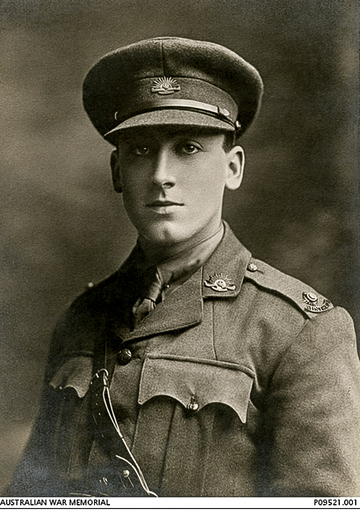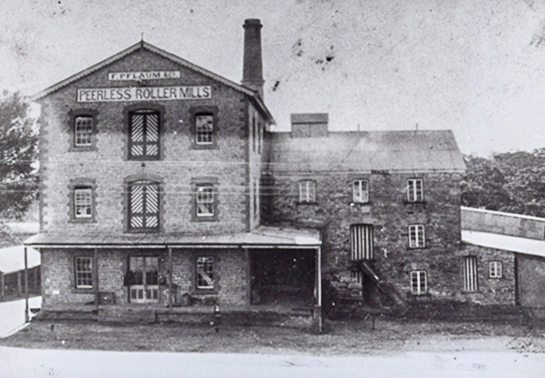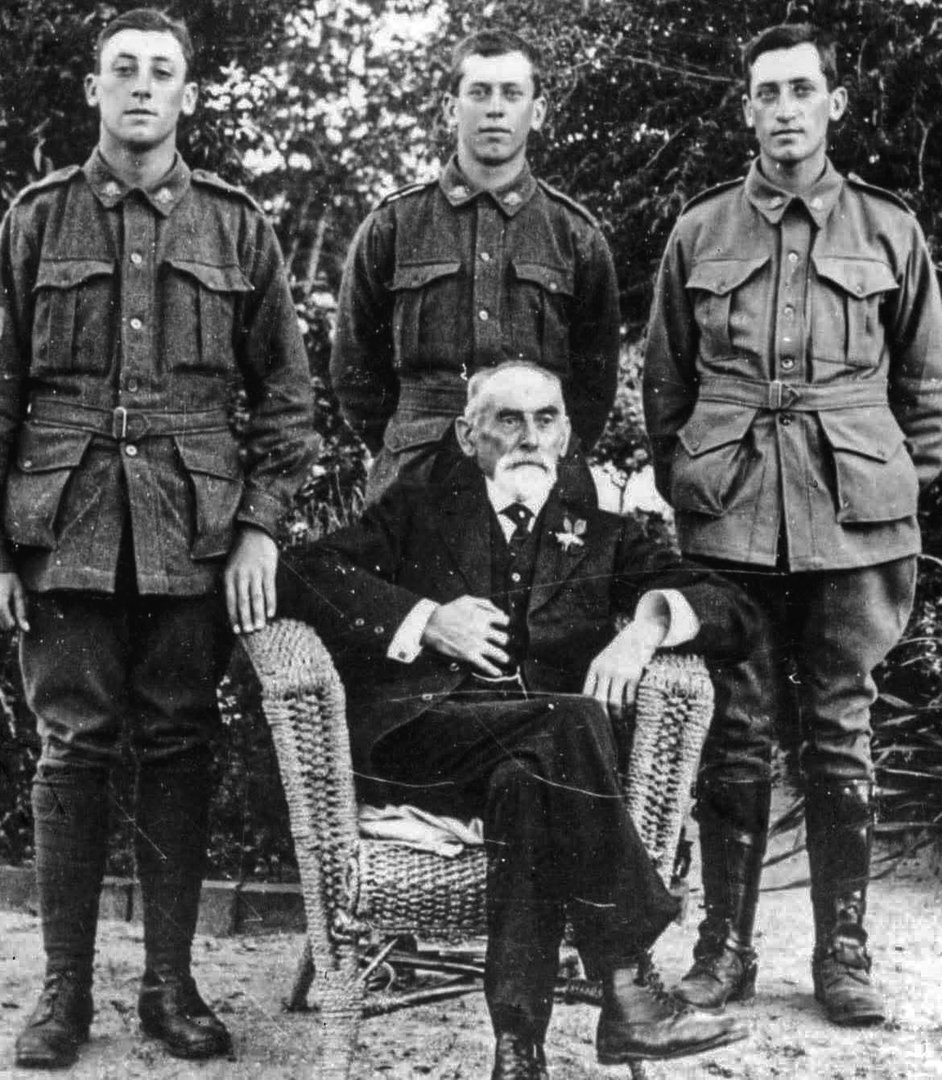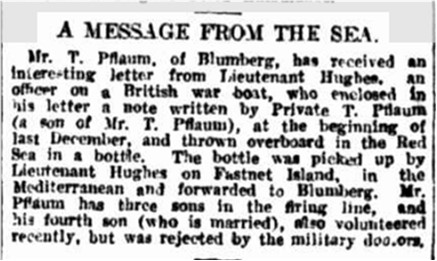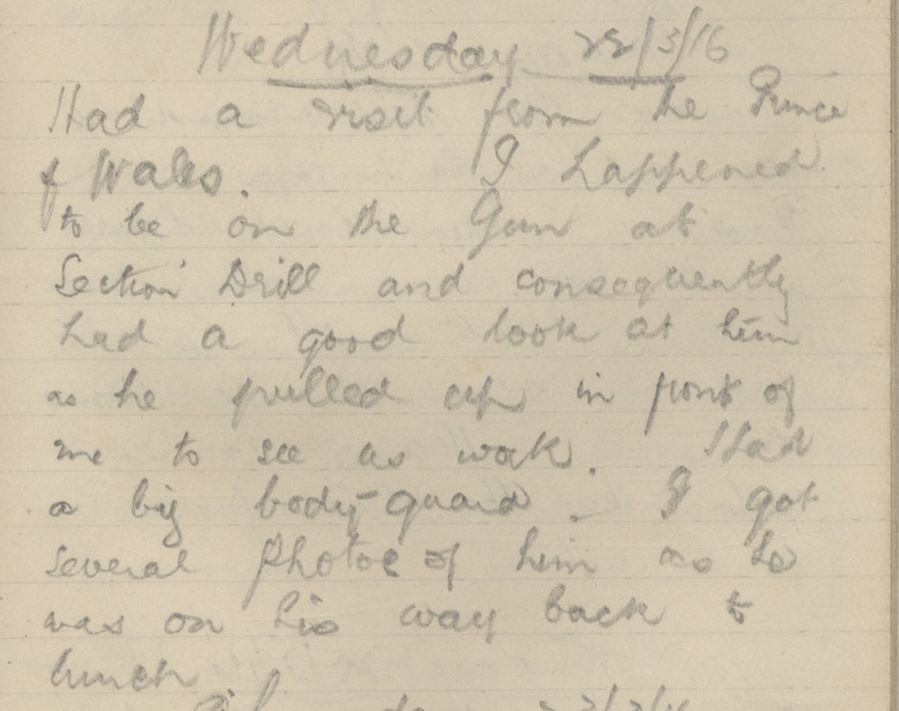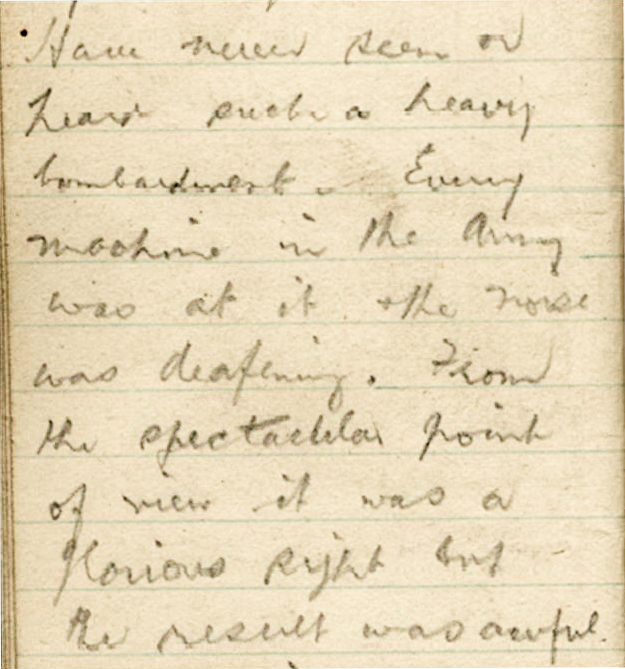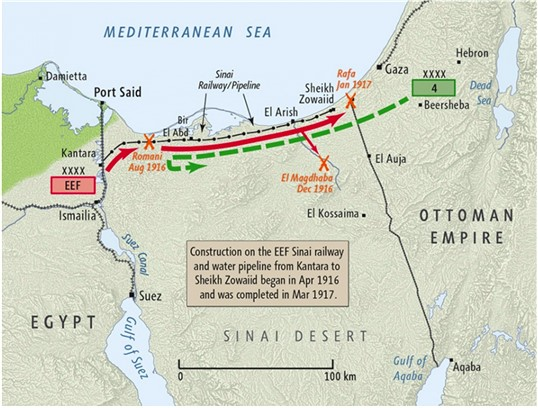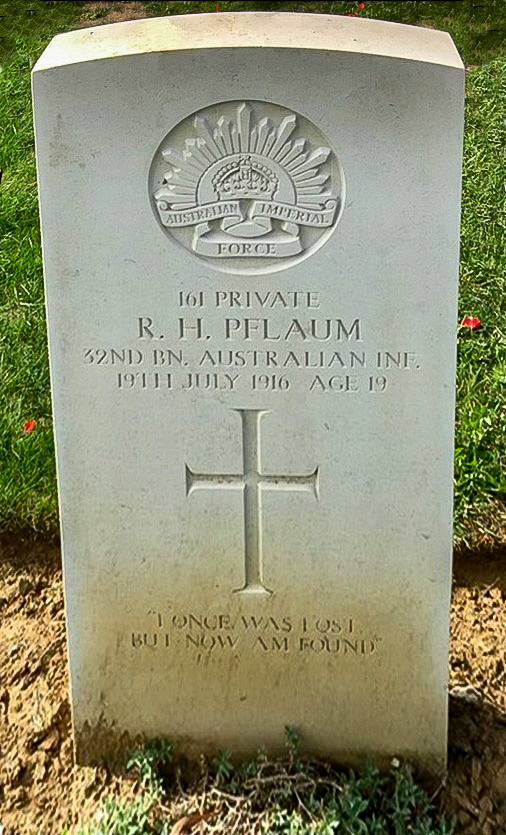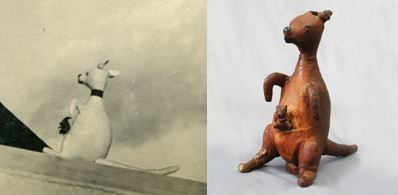Theodor Milton PFLAUM
Eyes hazel, Hair dark, Complexion medium
I ONCE WAS LOST, BUT NOW AM FOUND
Raymond, Theodor and Elliott (Tab) Pflaum’s story is not just a “soldier” story. It also has a recurring theme, respect.
Respect for one another within the family. Respect for their community. Respect for the Pflaum’s new country - three sons who fought, two who died. Respect for duty. And, finally, respect for the Pflaums themselves from their community, which continues to his day.
Family Background
Heinrich Pflaum and his brother Friedrich emigrated to South Australia in the late 1860’s. They quickly settled in and by the late 1870’s had established a tannin and flour mill in Blumberg (renamed Birdwood in 1917) in the Adelaide Hills. The mill prospered, winning prizes for their ‘Peerless’ superfine flour in international exhibitions.
The family was active in the community and their legacy is still intact. Heinrich and Fredrich served as councillors in the Talunga District Council and Friedrich went on to further involvement in politics. They were responsible for the Birdwood Institute and the Cemetery and their family home later became the primary school with Pflaum Street on the boundary of the school.
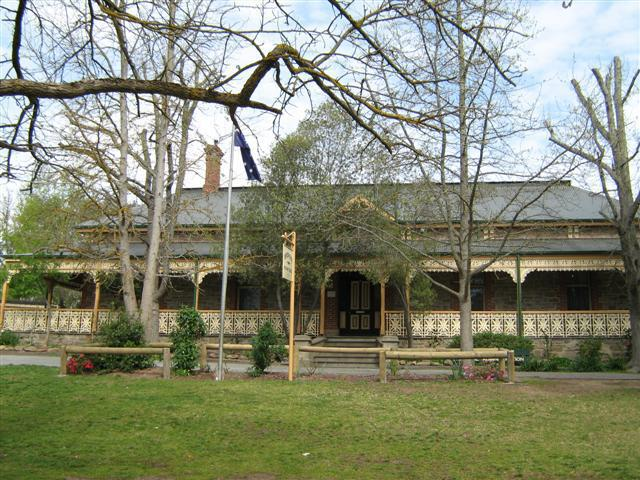
Raymond, Theodor and Elliott (Tab) were three of Heinrich and Mary Jane (nee Teile/Theel) Pflaum’s fourteen children. Tab was born in 1892, the 8th child, Theo in 1895, the 10th and Raymond in 1897, the 12th.
The boys all attended Blumberg High School and Prince Alfred College, Adelaide and were in the Cadets. Ray was also a member of the Blumberg Rifle Club.
They were sportsmen – playing sports including cricket, football and tennis. Theo was described in a news article:
“He excelled at tennis, cricket and football. His left hand drives and services were hard to beat at tennis; he bowled a fast medium ball at cricket, and was a reliable wicket getter for his side; and at football he is well remembered for his dashing play and marking on the left wing of the half-forward lines.”
After their initial schooling, Theo did a commercial course at Muirden College and worked as a clerk for Elder, Smith and Co. in Adelaide. Tab also was a clerk and Ray became a shop assistant.
A Family of German Speaking Immigrants, but Off to War for Australia
The Pflaums had come from the German speaking Schleswig-Holstein area of Denmark, but they emigrated when it was to become a part of Germany so that they did not have to be called up for service in the German army. When World War I broke out, their ‘historical’ allegiance was clearly not with Germany.
Ray and Theo enlisted on 21 July 1915 in Keswick South Australia. Tab followed a month later on 24 August. Ray and Theo were underage, 18 and 19, but they had the full support of their parents to head off to fight. Their younger brother Leonard also enlisted, but it was near the end of the War and he was discharged.
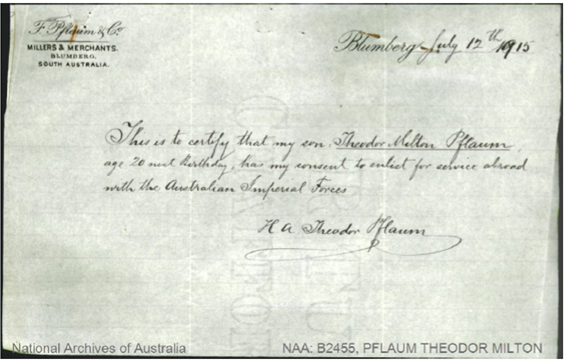
Ray and Theo were placed in the newly formed 32nd Battalion, but were assigned to separate companies, and Tab went to the 9th Light Horse Regiment. All three did their initial training at the Mitcham Camp, not far from Blumberg. After a short period of training, the three brothers all left for Egypt aboard HMAT A2 ‘Geelong’. Theo began a diary commencing from their 18 November departure. It is available online.
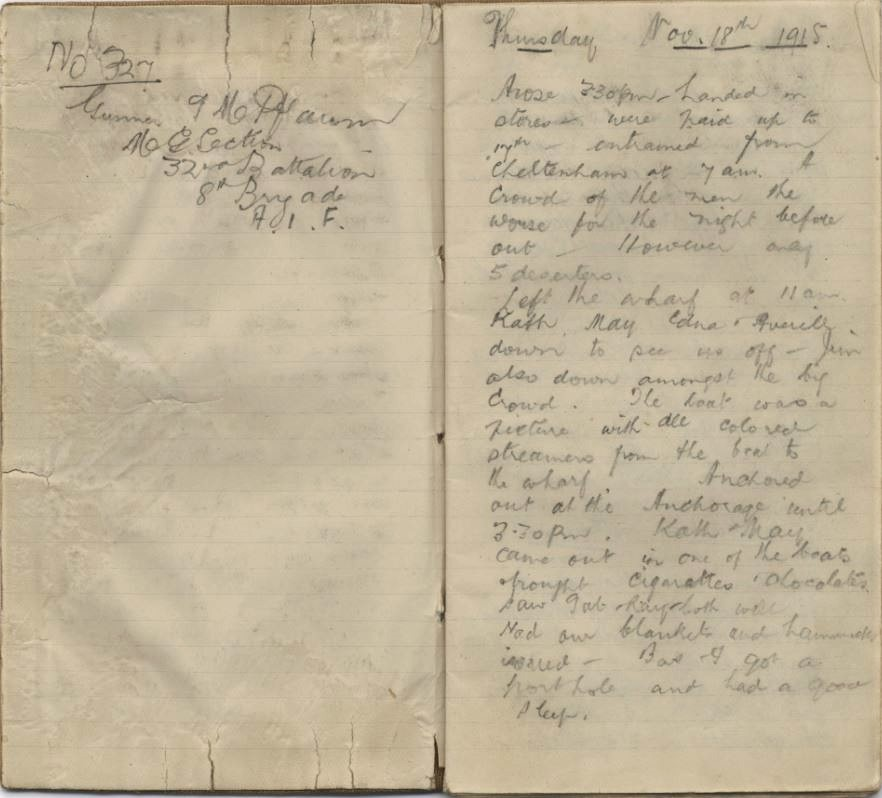
The departure of the 32nd Battalion was reported in The Adelaide Register:
“The 32nd Battalion went away with the determination to uphold the newborn prestige of Australian troops, and they were accorded a farewell which reflected the assurance of South Australians that that resolve would be realized.”
One ‘tradition’ for the departing soldiers was to send a message in a bottle. Surprisingly enough, Theo’s note was actually picked up in the Mediterranean and sent to the family!
They arrived at Suez a week before Christmas. Once in Egypt, however, the brothers started to go separate ways. Ray stayed with the 32nd Infantry, A Company, but on March 11th Theo was transferred to the 8th Machine Gun Company. He was also promoted to Corporal. Although in separate units, all three brothers remained in communication throughout their time in Egypt.
The 32nd’s training continued in El Ferdan, Ismalia, Tel-el-Kebir, Ferry Post, Duntroon Plateau and Moascar. Theo describes some of their food as “dog biscuits and beef” and notes that water was “scarce” on some of their long marches across the sands.
Both Ray and Theo were inspected by H.R.H. Prince of Wales in March 1916, with the Prince stopping to see Theo in action.
Ray and Theo Off to the Western Front
In mid-June, the call came to support the Western Front. Ray and Theo embarked from Alexandria aboard the ship ‘Transylvania’ on 17th June 1916 to join the British Expeditionary Force. They arrived at Marseilles on 23 June 1916. Tab remained in Egypt.
The two brothers departed Marseilles by train for the two-day trip to Hazebrouck, about 30 kilometres from Fleurbaix. Theo wrote that, “The people flocked out all along the line and cheered us as though we had the Kaiser as prisoner on board!!” (Source AWM C2081791 page 8)
Their route took them to a station just out of Paris where they saw the Eiffel Tower. They also went up through Boulogne and Calais, getting a view of the Channel before heading to Hazebrouck. Once off the train there were long marches and Theo wrote on 9 July that they were “well and truly fagged out”.
Ray and Theo had marched to their camp at Morbecque for more training, now focused on bayonets and the use of gas masks. D Company’s Lieutenant Sam Mills’ letters home were optimistic for the coming battle:
“We are not doing much work now, just enough to keep us fit—mostly route marching and helmet drill. We have our gas helmets and steel helmets, so we are prepared for anything. They are both very good, so a man is pretty safe.”
On 14 July, the 32nd moved into Fleurbaix and Ray was into the trenches on 16 July, one year after enlisting and only three weeks after arriving in France.

Theo’s diary captures the ominous atmosphere at the front:
“Have never seen or heard such a heavy bombardment. Every machine in the Army was at it and the noise was deafening. From the spectacular point of view it was a glorious sight, but the result was awful.”
The 32nd were reconnoitring the trenches and cutting passages through the wires preparing for an attack on 17 July, but it was called off due to the weather. While there was no direct combat, Theo noted that his unit had “got our baptism of German shrapnel.” The next day Theo saw Ray in the first line and wrote that “He was very well and just as cool as ever.” (AWM, C2081791, p 15)
The 32nd were back into the front trenches by 4.15pm on 19 July, preparing again for an attack. They were in position by 5.45pm and the charge over the parapet began at 5.53pm. Ray’s A Company was assigned to the first wave of the attack.
They were successful in their initial assaults and by 6.30pm were in control of the German’s first line system, which the unit’s war diary noted as “practically a ditch with from 1 to 2 feet of mud and slush at the bottom”.
Theo’s machine gun team was originally held in reserve, but were soon called up to provide support for the rapidly advancing soldiers. They began their efforts to carry heavy guns and ammunition across the lines.
The following extracts from Theo’s diary (AWM, C2081791, p 20-22) tell the tale of what happened next.
“Will I ever forget that rush for life…….At last we reached their trench and although I was exhausted I took a gulp for joy when I saw the other fellows behind me coming in one by one until the whole lot arrived.”
Theo’s relief for his own team’s charge was soon deflated by what he found in the trench.
“While the men were getting their wind, my attention was drawn to a wounded man along side of me just along a dug out. It was Ray -------- I ran down to him and was told he had got a piece of shrapnel in the stomach just as he was about to get into their trench. He was quite conscious and by his appearance didn’t seem to be hit too badly.”
“One of the other 32nd fellows helped me to put him in the dugout. I spoke to him and told him that our fellows had taken their 3rd line so that it was certain we would be able to hold the first…..”
“I managed to get him a flask of whiskey – (Mat Scouler had) and a mouthful of that seemed to make his spirits go up. He was not in a great deal of pain whilst lying still but could not bare (sic) to be moved. Although this takes room to write it was all done in a minute or so.“
As difficult as it had to be, Theo had to “soldier on” for the good of his own men.
“There were dozens of wounded about but I asked a 32nd fellow (slightly wounded in the foot) to do his best for Ray while he could. I then made my way down to find a position for my gun.”
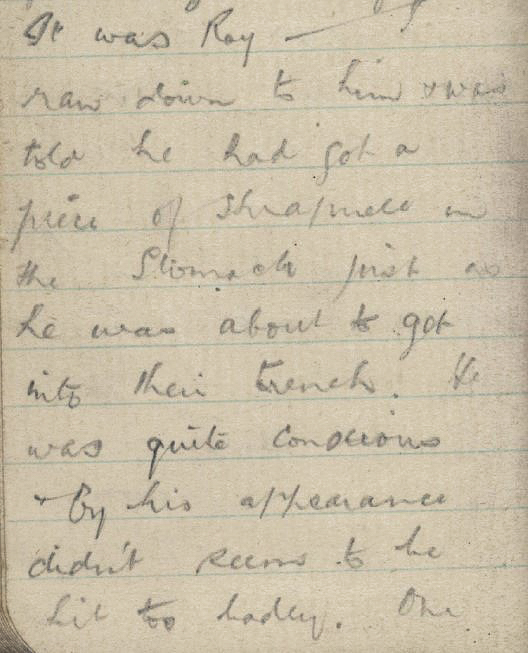
Fighting continued through the night. At 4 am, the Germans began their attack from the Australian’s left flank and then on the front.
A charge at the Germans’ firing line was made by the Australians, but they faced a number of obstacles: they were low on grenades; there was machine gun fire from behind from an emplacement at Delangre Farm; and, they were also so far advanced that they were getting shelled by both sides.
By 7:30am on the 20th, what was left of the 32nd had withdrawn.
Theo’s team had been ordered to retreat before the end of the battle so that the Germans could not capture their gun. Shortly afterwards he had time to reflect:
“…Twice during the whole time I felt faint - 1st when I got my orders to advance under fire? No – through Hell and 2nd when I had to leave Ray behind to the mercy of those ruthless creatures of “Kultur”*. I tried to get back to him but to no avail. However, I gulped hard and with what was left of my crew we made another dash for our line.”
Note “Kultur” is defined in Google’s English Dictionary as: German civilization and culture (sometimes used in a derogatory sense to suggest elements of racism, authoritarianism, or militarism)
The toll the attack took on the 32nd was devastating – 718 casualties, 90% of their effective strength.
While Theo’s original optimism that Ray would be safe where he was since the Australians had advanced well beyond where he saw Ray, it was not to be. Ray was not among those who had returned to the Australian lines.
Family maintains hope – but, what happened to Ray?
Ray hadn’t returned and a cease-fire to recover the wounded and killed was not agreed to by the commanders. Theo noted, “No armistice so the wounded simply have to chance to luck - poor devils.” (AWM C2081791 page 26)
In his diary (AWM C2081791 page 29), Theo noted that he sent a cable home on 25 July - “Ray wounded taken prisoner”, an assumption which would have fit with what he had seen during the battle. Two days later, he contacted the Enquiry Office in London.
In mid-September Theo wrote home again: “Had enquiry from London of Ray being prisoner – no definite word to date.” (AWM C2081791 page 33)
“Folk at home in a great stew as I anticipated. Would to God I could do something for Ray but still no news of him.”
(AWM C2081791 page 36)
Ray’s father wrote in November 1916 to another father of a soldier killed at the Battle of Fromelles summing up the frustration of not knowing:
“Our Ray is presumed to be wounded by shrapnel on the stomach in their attack July 19th and 20th (32nd Batt) & fell prisoner in the hands of the Germans by their counter flank attack obliging our boys to retreat. But so far cannot find any trace of him. We still hope on though hope grows fainter.”
Army records of early November 1916 show Ray as a POW and then a later (unofficial) report said he had died on 24 November while a POW in Germany. No details were provided to support either of these.
Ray’s identity disc was received from the Germans in March 1917 and a German letter, originally dated 2 August 1916, noted that he had fallen in the area of Fromelles on 19 July.
With no more information able to be provided by the Army, Ray’s father wrote on 6 July 1918 seeking the return of his sons’ personal belongings:
“Surely, they have given their (to us) valuable lives for King & Empire! Could we not get some of their personal belongings, which of course would be treasured by us in love”
Still seeking answers in September 1921, Ray’s sister Rose contacted Captain Mills, who had spent a year after the War trying to locate all the Australian POW’s who died while in German camps. Captain Mills wrote that he remembered Ray’s name on the list supplied to him and tracing him to a hospital and also a place of burial, but he could not be certain as his records had been passed on to others by that time. The Army later replied that Captain Mills must have been mistaken.
Ray’s nephew, Geoffrey Baker, later wrote:
“My Grandfather and Grandmother and family were advised by the Army that Ray had been taken as P.O.W. and died on 24 November 1916. Throughout the family lives, they did not believe he was taken as P.O.W. and always believed he died 19 July 1916.”
Ray lost but Theo’s War Continued
Theo remained in the Fromelles area until late September. The shelling continued, but there were no further attacks. With Theo having demonstrated his leadership in battle, he was promoted to sergeant on 1 September.
On 21 September (the day after his 21st birthday), he finally left the area and headed for the Belgian border.
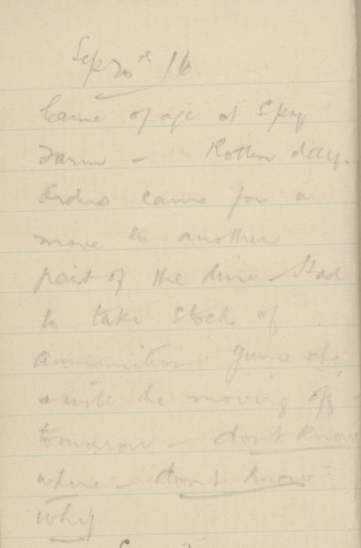
In late October 1916 he was outside of Bapaume, readying for action when he wrote:
“Dare I say I’ll have books of this to write if God wills I come through it. If not, it’s a noble cause and what better death.”
Theo survived this action, but remained in the area until February.
On 10 February 1917, he was transferred to the 25th Machine Gun Company, promoted to 2nd Lieutenant and sent to England. He received training in bombing and became an instructor for handling revolvers before returning to France on 7 September 1917 – just in time to celebrate a second birthday whilst on the front line.
On 24 September, his unit was engaged in the Battle of Menin Road. Theo, together with four other officers, was sent forward with fifty men to establish machine gun positions. While supervising sending of materiel to advanced positions, Theo was shot in the thigh, which resulted in a compound fracture. He was immediately sent to the 6th Field Ambulance Unit and then transferred to the 10th Casualty Clearing Station in Poperinge. Unfortunately, he was pronounced dead on arrival.
Theo is buried in the Lijssenthoek Military Cemetery, Flanders, Belgium, Plot 25, Row F Grave 2.
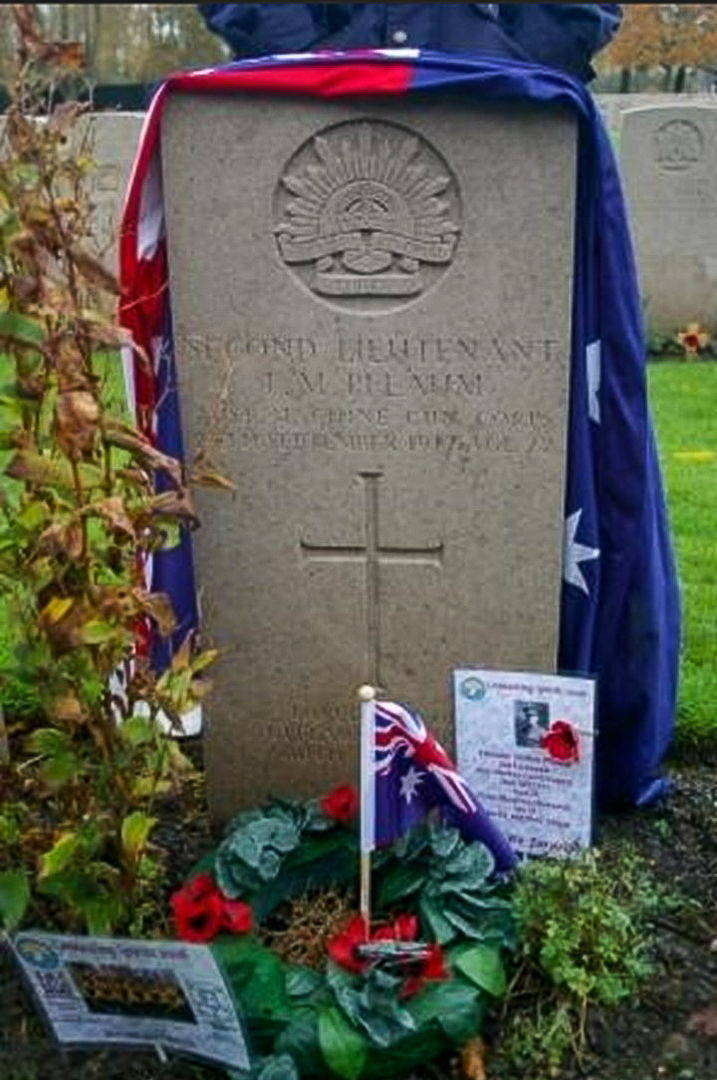
Tab – From the Light Horse to a Sopwith Camel
Tab’s 9th Light Horse Regiment had remained in Egypt. In mid-1915 they were called in to become part of the ANZAC Mounted Division for the Sinai campaign. The goal was to prevent Ottoman attacks on the Suez Canal.
The only major battle occurred in early August 1916 near the oasis town of Romani, where a 16,000-strong Turkish force attempted to destroy the advancing railhead. Although Tab’s unit didn't take a direct role in the battle, they were involved in the advance that followed the Turks' retreat across the desert.
Tab’s military career then took a sharp change, when on 14 December 1916 he joined the 68th Squadron of the Australian Royal Flying Corps. By 17 January 1917, he was headed for England for flight training – just before Theo also headed to England for training. Tab became a qualified pilot and was promoted to 2nd Lieutenant on 18 October 1917.
By mid-December, he was headed for the Western Front, flying there for his assignment. In his 3½ months on the Western Front, he flew a total of 70 hours on reconnaissance missions in his Sopwith Camel and was promoted to Lieutenant on 18 January 1918.
Life expectancy for WW1 pilots was short but luckily for Tab, in April 1918 he was transferred back to England to be an instructor in the 8th Training Squadron. His plane was painted white so young pilots in mock dog-fights could identify the instructor’s plane. In February 1919 he was promoted to Captain.
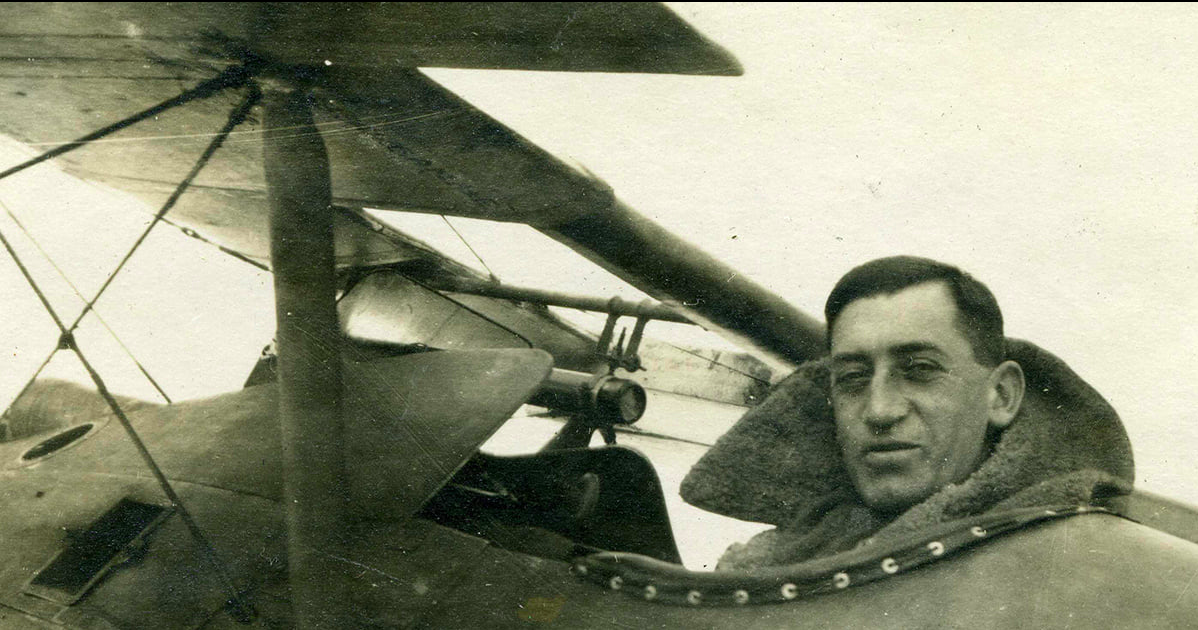
Tab returned to Australia on 14 June 1919, the only one of the three brothers to have returned home. He was discharged on 6 August 1919.
He married Clara Drabsch in 1920 and they had two children, Joan and John. Tab was an auctioneer and was the Chairman of the Local Council in Loxton, SA, from 1921 to 1923.
Tab’s support for the military continued, serving in the Army Citizen Military Forces in the Central Recruiting Depot from 1940-1948. His son John joined the Air Force in WW2. Unfortunately, John was killed in an aircraft accident in the Philippines, 15 November 1945, aged just 20.
Tab died on 18 August 1976 in Loxton and is buried in the Centennial Park Cemetery, Pasadena, Mitcham City, South Australia.
Ray’s Final Story - I Once Was Lost, but Now Am Found
In 2008, a mass grave that had been dug by the Germans outside of Fromelles was discovered. It contained the remains of some 250 soldiers.
With this discovery, there was an Australian Defence Force project to match up DNA of the soldiers in the grave with living relatives to help to identify and honour the soldiers properly.
Ray’s remains were among those positively identified in 2010. This finally proved that he had succumbed to his wounds in the trenches and the Germans recovered his body. He was NOT taken as a prisoner of war as his family had been advised.
The Pflaum family held a re-union at Birdwood on 10th April 2010 where 140 descendants attended, coming from all parts of the world to pay homage.
On 19th July 2010 several members of Ray’s family attended the special commemoration at the new military cemetery at Fromelles. Prince Charles and Quentin Bryce, the Governor General of Australia, were among those present to open the cemetery.
Respect Over the Generations
As noted at the start of this story, community respect the Pflaum family earned in generations past survives to this day.
After the war, Ray and Theo’s sisters each received a gold locket with photos of their lost brothers as mementos. The boys’ great nieces still wear these lockets today.
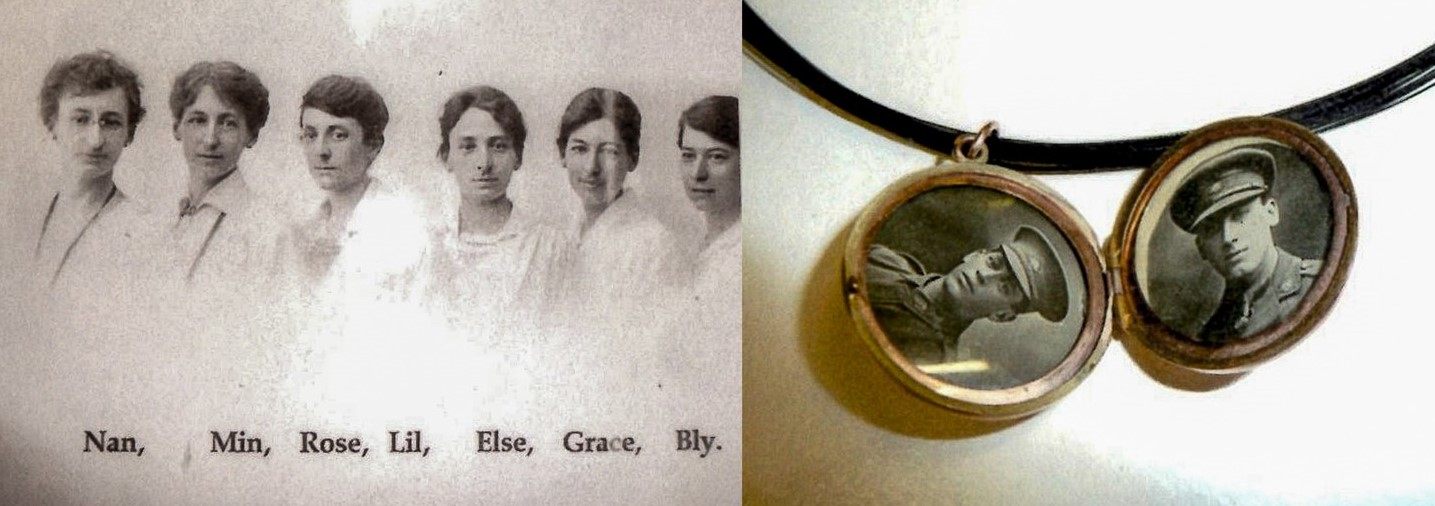
The Pflaum’s family house later became part of the Birdwood (formerly Blumberg) schools and the red sports team at Birdwood High School is named Pflaum house.
In 2006, Birdwood High School became involved in a project to study and travel to the World War 1 battlefields, cemeteries and memorials to learn first-hand of the role that Australians played in the battles. Flo Bourke was one of the students from Birdwood.
At age 19 - the age that Ray was when he died - Flo wrote a song, “Known only Unto God” about Ray’s story. In what seems almost too odd to be a coincidence, Flo had studied music as a year 7 student in the SAME room in which Ray Pflaum had been born.
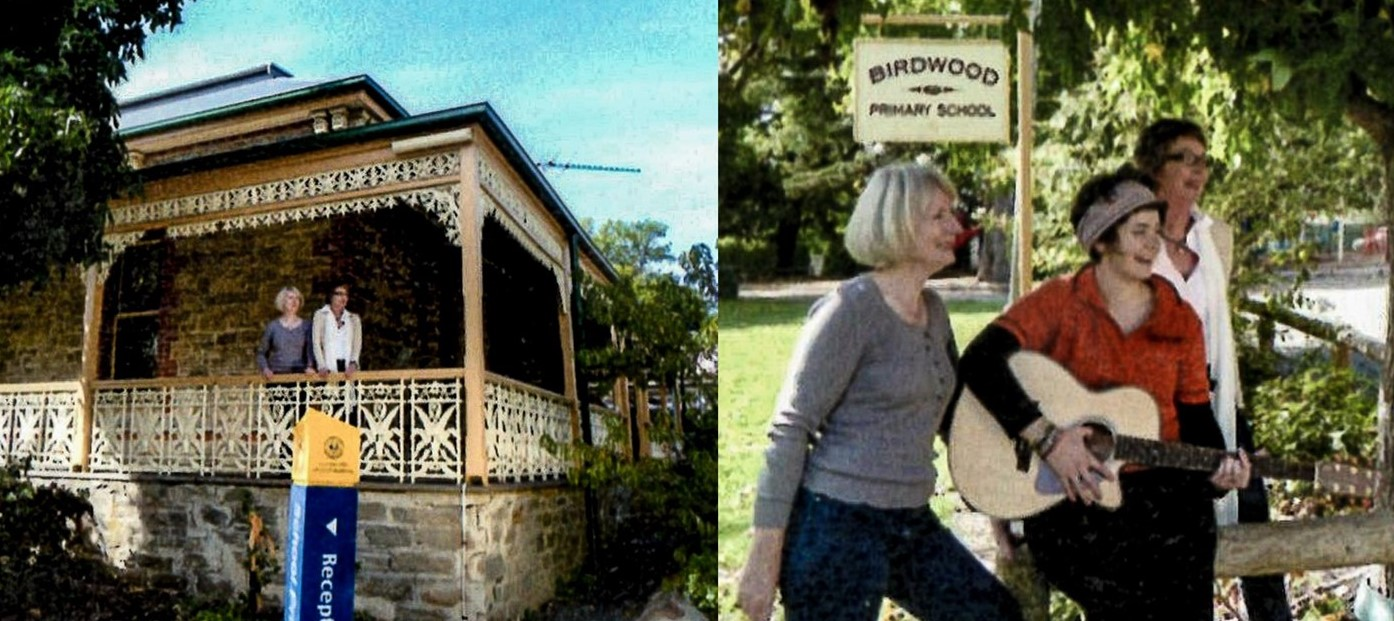
“Known Only to God” is written from the point of view of a mother who has lost her son to war and knows not where he lies. The poignant lines include:
“How could you not be somewhere in these rows and rows of white stones?
How could you not be found, how could you still not be known?”
And concludes with the recognition that he has now been found:
“But now not known only to God, but known unto us all.”
This song was performed during at the commemoration ceremonies at Cobbers’ Memorial on 19 July 2010, not long before the final soldier was laid to rest. Flo sang it personally when she visited Ray’s grave later that year. See a link to the song below (shared with permission, Flo Bourke).
Known Only to God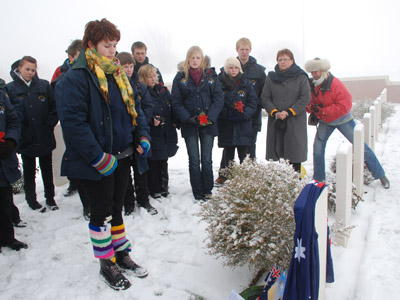
Tab has also received recent recognition. Artlab Australia featured a WW1 conservation project that they worked in 2016 on for a client who owned “Joey”, a small kangaroo mascot made from leather. “Joey” had been the little mascot that Tab had had fitted onto his aircraft, on top of the petrol cap, just behind the rear seat. “Joey” was exhibited in Keepsakes and Stories: Conserving Mementos from WW1 exhibition held at Artlab Australia in 2016 and was included in a 2021 Remembrance Day article.
The brothers are also commemorated at:
- Gumeracha District Soldiers’ Memorial Hospital WW1 Honour Board
- Birdwood Institute Honour Board
- Birdwood WW1 & WW2 Soldiers’ Memorial
- Adelaide Elder Smith & Co Limited WW1 Honour Board, and
- the family headstone in Birdwood Cemetery.
A truly Australian story coming from a family of German-speaking Danish immigrants.
The Fromelles Association would love to hear from you

Contacts
(Contact: carla@fromelles.info or geoffrey@fromelles.info).
(Contact: army.uwc@defence.gov.au or phone 1800 019 090).
Donations
If you are able, please contribute to the upkeep of this resource.
(Contact: bill@fromelles.info ).
